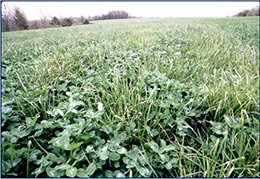
Cover crops can be established for a variety of agronomic benefits. These include preventing soil erosion, providing weed suppression, and improving soil health, potentially increasing yields for crops such as corn and soybeans that may be planted in a crop rotation system. Cover crops can be used with most agriculture production systems, including double-crop systems or used as a livestock forage (Figure 1). Examples of cover crops used in Missouri include cereal crops, brassicas and legumes. MU Extension publication G4161, Cover Crops in Missouri: Putting Them to Work on Your Farm provides an overview of the important benefits from cover crops. Recommendations are included for plant selection and seeding rates as well as management techniques for agronomic benefits. Popular cover crops include cereal rye, crimson clover and oilseed radish. Small grain crops, such as wheat and barley, can also be adapted for use as cover crops.
Table 1 lists a selection of cover crop species recommended in Missouri. In addition, the Midwest Cover Crop Council has developed an updated Cover Crop Selection Tool for the region.
Table 1. Examples of selected warm- and cool-season cover crops.
| Warm-season cover crops (for summer planting) | Cool-season cover crops (for fall or early spring planting) | |
|---|---|---|
| Buckwheat | Austrian winter pea | Forage turnips |
| Cowpea | Balansa clover | Hairy vetch |
| Foxtail millet | Black oats | Oats |
| Pearl millet | Brassicas | Oilseed radish |
| Sorghum-sudangrass | Canola (rapeseed) | Triticale |
| Sunflower | Cereal rye | Wheat |
| Sunn hemp | Crimson clover | |
In addition to the agronomic benefits, cover crops can also enhance wildlife and pollinator habitats on your farm. Depending on plant selection and management, cover crops can provide important food and cover resources that benefit a variety of wildlife species during various seasons of the year. Flowering cover crops also support the habitat requirements of bees and other pollinators by providing nesting areas, pollen and nectar resources — as well as enhancing overall insect diversity.
Cover crops for wildlife benefits
All wildlife require certain habitats to survive. Habitat components are those that provide wildlife with food, cover, water and space. Plant composition, plant vegetative structure and the management practices that are conducted greatly influence the quality of habitat for wildlife.
Providing food and cover for a variety of wildlife
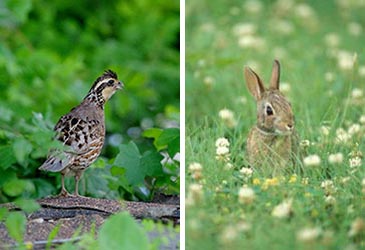
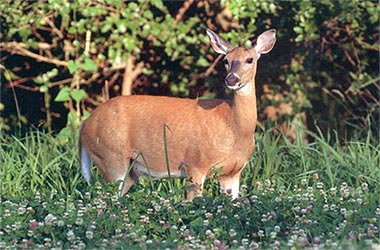
Cover crops can provide important sources of food and cover for a variety of species, particularly during a time of year when conventional crop fields (such as corn and soybean fields) have been harvested and are fallow. Crop rotations featuring mixtures of cover crops also add diversity to the agricultural landscape and potentially increase the usable space on farms for a variety of wildlife species including northern bobwhite quail, cottontail rabbits, mourning doves, grassland songbirds and other species that require early stages of plant succession (Figure 2). Wildlife also benefit when cover crops are established and combined with other practices that improve soil health and conservation. Judicious use of pesticides leads to greater insect biomass available to birds, and reduced tillage or no-till leaves residual cover which can provide birds with greater amount of food available. Minimizing tillage and equipment passes through a field also reduces the likelihood of destroying nests during the spring and early summer. In addition, many of the food plot recommendations for species such as white-tailed deer and wild turkey contain a variety of legumes and mixes of native forbs that can also be used as a cover crop. MU Extension publication G9493, Enhancing White-Tailed Deer Habitats on Your Property: Food Plots provides more in-depth information on plants that can be useful in food plot mixes. These can be established to provide supplemental sources of food for use during a particular season, such as the late fall and winter, when other sources of native foods are limited (Figure 3).
Providing areas for nesting habitat and management strategies to ensure nest success
Many species of songbirds — both year-round and migratory residents — use cover crops for sources of food as well as for nesting habitat. One study in Illinois found a greater abundance of songbirds and waterfowl in fields with cover crops than in fields in which no cover crops were established as part of the crop rotation. Regardless of the season, a diverse mix of cover crops offers the most benefit to a greater variety of bird species. Cover crops are also used by a diversity of insects, providing additional foods for birds. The vegetative structure created by planting a mixture of cover crop species provides opportunities for improved nesting and brood-rearing habitat that ground-nesting birds such as bobwhite quail and grassland birds can utilize. However, ground nesting birds, including grassland birds (such as meadowlarks, grasshopper sparrows, dickcissels and other species), bobwhite quail and wild turkey have a window of time in the spring when nests are initiated, eggs are hatched and young birds are off the nest. Management strategies for delaying planting of certain row crops to a period of time after these nests have produced young birds can certainly enhance their survival.
Habitat for small mammals and management strategies for controlling crop damage
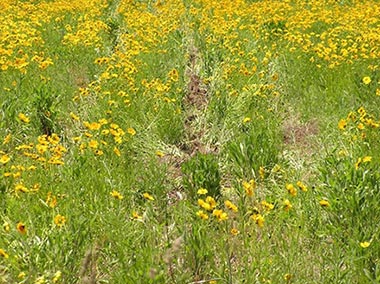
Small mammals such as rabbits, field mice and voles will also utilize fields with cover crops for the food and cover that are available (Figure 4). This includes protective cover required by many of these species. As a result, populations of rodents, such as voles can increase to a level that could damage the subsequent crop. However, the presence of these small mammals on cover cropped fields also provides food for predators such as coyotes, foxes, hawks and owls. Management techniques used to terminate the cover crop can also serve to prevent damage to the subsequent crop and these are discussed in following sections. Information on controlling nuisance voles and mice can be found in the additional resources section at the end of this guide.
Cover crops for pollinator benefits
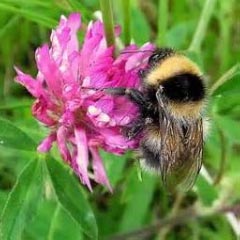
A variety of pollinator species greatly benefit from the establishment of cover crops (Figure 5). There are hundreds of species of native bees and thousands of species of butterflies, flies, wasps and beetles that also act as pollinators. In most cases, native pollinators are sufficient for pollinating crops. However, row crops are not able to fully support a diversity of pollinators. In these instances, cover crops can help provide crucial habitat for honeybees and many other pollinator species. The most important resources for pollinators are the pollen and nectar provided by flowering plants. Cover crops that flower can help pollinators meet their food requirements. But pollinators need more than just pollen and nectar. Most native bee species nest in the soil or in dead vegetation, which cover crops can provide even if they do not flower.
Management techniques for improving cover crops for pollinator benefits
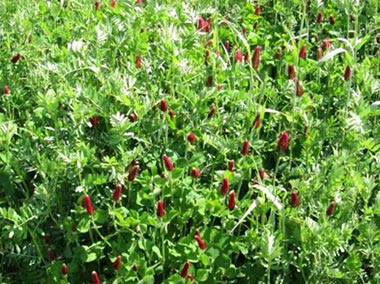
Utilizing cover crops for pollinators takes careful planning and consideration, from establishment and management practices to the termination of the crop. Management techniques need to be considered when establishing cover crops for pollinators and other beneficial insects. These include:
- Establishing a mixed stand of forbs and legumes to provide a greater diversity of plants that provide seeds and that attract insects which are important foods for a variety of pollinator species (Figure 6).
- Planting a diverse mix of cover crops to support a greater variety of pollinator communities than would be provided by a single-species cover crop. Cover Cropping for Pollinators and Beneficial Insects provides assistance in identifying plants with bloom times that are compatible with your production system and attractive to pollinators.
- Establishing summer cover crops such as buckwheat or sunflowers that have a longer flowering period compared with fall-planted cover crops.
- Allowing cover crops to flower through peak bloom is vital for pollinators. Ideally, a cover crop mix will include species that flower at different times to ensure that pollinators have a food resource throughout the season.
Cover crops also benefit pollinators when combined with other farm management practices. These include:
- Minimizing tillage operations to preserve nesting habitats for ground nesting native bees and overwintering cover for other pollinators and beneficial insects.
- Establishing perennial native vegetation that includes flowering plants which gives pollinators an undisturbed refuge for food and nesting habitat. Examples include windbreaks, riparian buffers, hedgerows, and field borders.
- Intercropping with flowering plants and living mulches such as white clover to provide pollen and nectar sources throughout the entire growing season.
- Minimizing the use of systemic insecticides that contain neonicotinoids. Neonicotinoids are taken up into plant tissues and are sometimes found in nectar and pollen ingested by pollinators. Even if pollinators are not killed from ingesting the nectar or pollen, they may suffer sub-lethal effects, such as an impaired ability to move and pollinate. Non-treated crop seed can be requested from seed dealers as part of an overall pollinator-friendly crop management strategy.
Management strategies using cover crops for wildlife and pollinators
A case study at the University of Missouri was recently conducted that provides information on how these practices can enhance soil health and wildlife and pollinator habitat. The study demonstrated that winter annual cover crops can be consistently established after corn or soybean harvest by drilling directly into the stubble during fall and spring months, depending on the crop production rotation in place. These practices improved insect diversity and pollinator populations and also enhanced the food and cover available within the crop field for wildlife. Establishing a three-year rotation that includes wheat prior to planting corn the next spring also provides an opportunity to plant summer cover crops that biologically fix nitrogen (benefiting the corn crop) and produce an abundance of biomass to enhance soil health. As discussed earlier, these practices can also improve habitats for pollinators and wildlife. A common practice in Missouri and other Midwestern states is to overseed red clover or Korean lespedeza into wheat during winter to provide summer forage for livestock. During the summer flowering period, these forage species attract insects and set seeds that are beneficial for wildlife. A number of native annual plants, such as partridge pea, plains coreopsis, and ox-eye sunflower, can be successfully established by overseeding during the winter and can attract a wide diversity of insects and provide cover and annual seeds that are important for wildlife the following summer. Utilizing native species such as these in plant mixtures along with proven non-native species can enhance plant diversity and provide additional benefits to soil health and wildlife. Cool-season crops such as wheat or rye — provide food resources for mammals like white-tailed deer and birds. Seeds are consumed by birds when plants are summer dormant. To increase diversity and habitat, plant warm-season crops such as sorghums, millets and sunflowers and warm-season legumes such as cowpeas and sunn hemp. These are all excellent producers of seed for birds and succulent vegetation for deer. These crops also provide brood rearing cover for young bobwhite quail chicks and nesting cover for ground-nesting birds such as bobwhites and wild turkey. Many of these cover crops can be established to benefit pollinators such as bees, wasps, butterflies and moths. Planting cover crop mixtures with different flowering times throughout the season extends the period of time when food sources are available. Table 2 provides information on bloom times for various native forbs and wildflowers that can be used in various mixtures.
Table 2. Flowering time of selected native wildflower/forb species mix.
| Species | Flowering time | ||
|---|---|---|---|
| March to May | June to August | September to November | |
| Blackeyed Susan | x | x | |
| Coneflower – Purple | x | x | |
| Coneflower – Grey-headed | x | x | |
| Partridge Pea | x | x | |
| Rattlesnake Master | x | ||
| Sunflower – Oxeye | x | x | x |
| Sunflower – Ashy | x | ||
| Clover – Purple Prairie | x | x | |
| Foxglove Beardtongue | x | x | |
| Prairie Blazing Star | x | ||
| Blue Sage | x | x | |
| Stiff Goldenrod | x | ||
Common crop rotations
There are a number of crop rotations that work well with cover crops. One common rotation in Missouri is a three-year corn/soybean/corn rotation with fall cover crops every year, including a winter cover crop of cereal rye following corn and a mixture of cereal rye/clover/brassica following soybeans. Indications are that this scenario has had long-term benefits in terms of fertilizer and pesticide cost savings, with no reduced yield. Cover crop recipes were developed to help Midwest farmers new to cover crops.
Cover crop termination strategies to benefit wildlife and pollinators
A major concern for Missouri farmers is potential conflicts from cover crops during corn planting in the spring. Therefore, a termination strategy is important. Management to terminate the cover crop depends on the skills of the producer. For producers just beginning to use cover crops, termination should be two to three weeks before planting while the cover crop is still in the vegetative stage. As a producer's skill with cover crops increases, termination may be delayed until planting.
There are also management decisions for terminating the cover crop during the year prior to planting corn, soybeans or other grain crops. These are a few recommendations to consider to minimize negative impacts on wildlife and pollinators:
- If possible, delay termination until most of the cover crop is past peak bloom.
- If waiting until peak bloom is not possible, consider leaving strips of the cover crop standing in the field to provide habitats for beneficial insect populations later into the spring. For example, buckwheat can be planted over a period of time and then mowed in strips to lengthen the bloom period while still preventing buckwheat from reseeding.
- Terminate with as little physical disturbance as possible. Roller-crimping may be less disruptive to pollinator nests embedded in the soil than cultivation.
- Leave as much cover crop residue as possible to protect beneficial insect eggs and any hibernating adults.
Economic considerations
Cover crop benefits are obvious in principle but often difficult to quantify. Measurable economic benefits occur when cover crops result in higher crop yields, better fertility cycling, nitrogen fixation, improved weed control, reduced compaction, quality grazing and enhanced drought resilience. Over a longer time frame, cover crops can maintain productivity and land value by reducing soil erosion, improving soil structure and increasing moisture holding capacity. Cover Crop Economics from Sustainable Agriculture Research and Education provides further information about the economics of cover crops.
There are also benefits for society beyond the wildlife and pollinator benefits mentioned previously. Cover crops improve water quality, decrease silting of waterways, increase carbon sequestration and improve biodiversity. These environmental benefits warrant USDA cost share programs available to assist U.S. farmers with the expense of adopting cover crops. Federal cost share through Environmental Quality Incentive Program (EQIP) is available from local USDA service centers. State and county cost share is available through Soil and Water Conservation Districts.
Table 3 presents a range of estimated costs of establishing cover crops. These suggest costs ranging from $20 to $110 per acre, without cost-share incentives included. Costs can include inputs such as seed and fertilizer as well as field activities of fertilizing, planting, and termination. Seed costs depend upon the mix. Fertility costs range from no fertilizer to 15 pounds of nitrogen, plus application costs. Planting costs range from broadcast seeding to no-till drilling. Termination costs range from none needed to herbicide application.
Table 3. Costs of seeding cover crops in Missouri, 2022.
| Category | Range of costs (dollars per acre) | |
|---|---|---|
| Low | High | |
| Seed | $10.00 | $50.00 |
| Fertilizer | $0.00 | $20.00 |
| Planting | $10.00 | $20.00 |
| Termination | $0.00 | $20.00 |
| Total | $20.00 | $110.00 |
| Note: Custom rates from MU Extension Publication G302, Custom Rates for Farm Services in Missouri. | ||
Economic benefits of cover crops are farm specific. Benefits vary due to differences in soils, management expertise, crops grown, weather and pest pressure. Economic studies differ on the net benefits of cover crops. Some of the barriers to adoption include lack of labor during critical seasons, new equipment needs, increased management required, inconsistent results and whether to use cover crops on short-term land leases.
Conclusion
Cover crops can provide seasonal habitats for wildlife and pollinators while also improving soil health. This potentially increases crop yields and provides other conservation benefits. Although crop rotation systems that include a diversity of cover crops provide seasonal habitats for pollinators and wildlife, there remains a need to provide areas of permanent habitat and cover throughout the year. These areas of permanent cover (commonly referred to as “sanctuaries” or “refuges”) are typically composed of early successional vegetation and have proven to be extremely important to pollinators and wildlife. Field borders provide locations within the agricultural landscape that can be used to increase plant diversity and transitional zones of habitat around crop fields. Other locations that can be established for these habitats include unproductive areas of crop fields. Precision agriculture technologies like yield maps can be used to identify these areas and may help transition to these types of conservation practices. Many species of cover crops can also be used in these areas to provide sources of food and cover for wildlife. Research has also shown that a 30-foot field border established with a variety of native forbs, legumes, and warm-season grasses planted adjacent to a crop field will provide flowering plants utilized by pollinators from the spring through the fall. Studies have also shown that these refuges can provide a diversity of predatory insects and can reduce the number of economic pests in corn and other crops. Utilizing these types of field borders in combination with crop rotation systems that feature winter and summer annual polyculture cover crops will provide diverse habitats throughout the year that benefit pollinators and wildlife and improve soil health.
Resources
Sustainable Agriculture Research and Education
Cover Crop Effects on Deer and Other Mammalian Wildlife
Cover Crop Effects on Songbirds and Game Birds
Cover Crop Impacts on Pollinators
Cover Cropping for Pollinators and Beneficial Insects
Cover Crops for Sustainable Crop Rotations
Midwest Cover Crop Council
Cover Crop Termination Guidelines
MU Extension
G4161, Cover Crops in Missouri: Putting Them to Work on Your Farm
G4163, Growing Buckwheat for Grain or Cover Crop Use
G4162, Growing Canola for Oilseed or Cover Crop
G4164, Growing Millets for Grain, Forage or Cover Crop Use
G4701, Sunflowers: A Versatile Native Crop
USDA Natural Resources Conservation Service
Cover Crop Conservation Practice Standard 340 (PDF)
A Comparison of Cool-Season Cover Crop Seeding Rates in Northeastern Missouri.
Acknowledgement: Portions of this publication have been adapted from these resources developed by Joe LaRose and Rob Myers with the USDA Sustainable Agriculture Research and Education (SARE) Program at the University of Missouri.
Photo credits: Missouri Department of Conservation, Robert Pierce, Tim Reinbott.